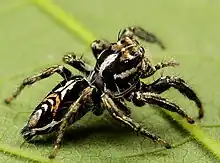Hyllus nigeriensis
Hyllus nigeriensis is a species of jumping spider in the genus Hyllus that is endemic to Nigeria. It lives in rainforest. The spider was first described in 2012 by Wanda Wesołowska and G. B. Edwards. A medium-sized spider, it typically has a cephalothorax 4.1 mm (0.16 in) long and an abdomen 4.0 mm (0.16 in) long. The abdomen is reddish-brown and narrower than the light brown carapace. Originally tentatively allocated to the genus Brancus, the species was allocated to Hyllus in 2022. Only the female has been described.
| Hyllus nigeriensis | |
|---|---|
 | |
| A related species, Hyllus argyrotoxus | |
| Scientific classification | |
| Domain: | Eukaryota |
| Kingdom: | Animalia |
| Phylum: | Arthropoda |
| Subphylum: | Chelicerata |
| Class: | Arachnida |
| Order: | Araneae |
| Infraorder: | Araneomorphae |
| Family: | Salticidae |
| Subfamily: | Salticinae |
| Genus: | Hyllus |
| Species: | H. nigeriensis |
| Binomial name | |
| Hyllus nigeriensis (Wesołowska & Edwards, 2012) | |
Taxonomy
Brancus nigeriensis is a jumping spider that was first described by Wanda Wesołowska and Glavis B. Edwards in 2012.[1] It is one of over 500 species identified by the Polish arachnologist Wesołowska.[2] They tentatively allocated it to the genus Brancus based on its body shape.[3] The genus had been first raised by Eugène Simon in 1902, and contained spiders that had a distinctive body shape, with a slightly pear-shaped carapace and an elongated narrow abdomen.[4] In their comprehensive revision of the genus in 2022, Wesołowska and Anthony Russell-Smith transferred the species to Hyllus.[5] The genus, first raised by Carl Ludwig Koch in 1846, is similar to Evarcha, differing in size.[6] Molecular analysis confirms that they are related but the precise relationship between the genera is unknown and species from one genus are sometimes misidentified as members of the other.[7][8]
The genus Hyllus is found throughout Africa and contains one of the largest jumping spiders discovered.[9] In Wayne Maddison's 2015 study of spider phylogenetic classification, the genus Hyllus was placed in the clade Saltafresia.[10] He considered that it a member of the subtribe Plexippina in the tribe Plexippini.[11] Two years later, in 2017, Jerzy Prószyński grouped the genus with nine other genera of jumping spiders under the name Hyllines, which was named after the genus. He used the shape of the embolus as a distinguishing sign for the group.[12] Hyllines was itself tentatively placed within a supergroup named Hylloida, again named after the genus.[13] The species is named for the country were it was first discovered.[3]
Description
The spider is medium-sized. The female has a cephalothorax that is typically 4.1 mm (0.16 in) long and 2.7 mm (0.11 in) wide. It has an oval light brown carapace that is slightly flattened and has a scattering of short brown hairs. The eye field is short and black, with transparent hairs and long brown bristles evident near the eyes themselves. The clypeus is very low. The chelicerae are light brown, with a single tooth visible at the front. The sternum and mouthparts are orange. The abdomen is narrower than the carapace, typically 4.0 mm (0.16 in) long and 2.0 mm (0.079 in) wide. It is red brownish apart from a light serrated stripe down the middle and is covered in colourless hairs interspersed with some longer brown bristles. The underside is yellow with three blackish bands that converge at the dark grey spinnerets. The legs are yellowish-orange with brown hairs, the foremost pair being shorter than the others. The spider has an epigyne that has two oval depressions divided by a ridge and a shallow notch at the edge of the very rear. The internal structure of the epigyne is simple. It has relatively short seminal ducts that lead to thick-walled spermathecae and two widely spaced pockets.[3] The male has not been identified.[1]
Distribution and habitat
The species is endemic to Nigeria.[1] The holotype was found in the Cross Rivers State in 1980. It lives in rainforest.[14]
References
Citations
- World Spider Catalog (2022). "Hyllus nigeriensis (Wesołowska & Edwards, 2012)". World Spider Catalog. 23.5. Bern: Natural History Museum. Retrieved 17 October 2022.
- Wiśniewski 2020, p. 6.
- Wesołowska & Edwards 2012, p. 742.
- Wesołowska & Russell-Smith 2011, p. 40.
- Wesołowska & Russell-Smith 2022, p. 121.
- Maddison 2015, p. 250.
- Maddison & Hedin 2003, p. 540.
- Wesołowska & Russell-Smith 2000, pp. 25–26.
- Wesołowska & Cumming 2004, p. 579.
- Maddison 2015, p. 246.
- Maddison 2015, p. 280.
- Prószyński 2017, p. 35.
- Prószyński 2017, p. 31.
- Wesołowska & Edwards 2012, pp. 741–742.
Bibliography
- Maddison, Wayne P. (2015). "A phylogenetic classification of jumping spiders (Araneae: Salticidae)". The Journal of Arachnology. 43 (3): 231–292. doi:10.1636/arac-43-03-231-292. S2CID 85680279.
- Maddison, Wayne P.; Hedin, Marshal C. (2003). "Jumping spider phylogeny (Araneae: Salticidae)". Invertebrate Systematics. 17 (4): 529–549. doi:10.1071/IS02044.
- Prószyński, Jerzy (2017). "Pragmatic classification of the World's Salticidae (Araneae)". Ecologica Montenegrina. 12: 1–133. doi:10.37828/em.2017.12.1.
- Wesołowska, Wanda; Cumming, Meg S. (2004). "A redescription and natural history of Hyllus treleaveni Peckham et Peckham, 1902, the largest jumping spider in Africa (Araneae: Salticidae)". Annales Zoologici, Warszawa. 54: 579–586.
- Wesołowska, Wanda; Edwards, Glavis B. (2012). "Jumping Spiders (Araneae: Salticidae) of the Calabar Area (SE Nigeria)". Annales Zoologici. 62 (4): 733–772. doi:10.3161/000345412X659786. S2CID 86538550.
- Wesołowska, Wanda; Russell-Smith, Anthony (2000). "Jumping spiders from Mkomazi Game Reserve in Tanzania (Araneae Salticidae)". Tropical Zoology. 13 (1): 11–127. doi:10.1080/03946975.2000.10531126.
- Wesołowska, Wanda; Russell-Smith, Anthony (2011). "Jumping Spiders (Araneae: Salticidae) from Southern Nigeria". Annales Zoologici. 63 (3): 553–561. doi:10.3161/000345411X603409. S2CID 83517018.
- Wesołowska, Wanda; Russell-Smith, Anthony (2022). "Jumping spiders from Ivory Coast collected by J.-C. Ledoux (Araneae, Salticidae)". European Journal of Taxonomy. 841: 1–143. doi:10.5852/ejt.2022.841.1943.
- Wiśniewski, Konrad (2020). "Over 40 years with jumping spiders: on the 70th birthday of Wanda Wesołowska". Zootaxa. 4899 (1): 5–14. doi:10.11646/zootaxa.4899.1.3. PMID 33756825. S2CID 232337200.